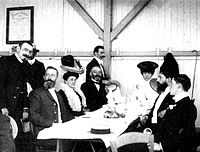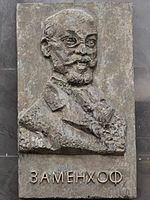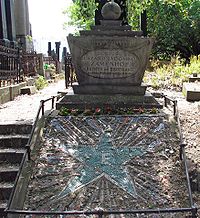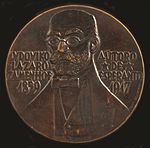- L. L. Zamenhof
-
For other people with the same name, see Zamenhof (disambiguation).
Ludwig Lazarus Zamenhof 
Born Leyzer Leyvi Zamengov
December 15, 1859
Białystok, Russian Empire (now Poland)Died April 14, 1917 (aged 57)
Warsaw, PolandNationality Polish Ethnicity Jewish Citizenship  Russian Empire
Russian EmpireKnown for Devising Esperanto Esperanto Esperantist · Esperantujo · Film
La Espero · Libraries
Literature · Music
Native speakers
Pop culture references
Publications · Symbols
Zamenhof Day
ProfanityAmikeca Reto · Kurso de Esperanto
Esperanto Academy · Encyclopedia
Pasporta Servo · TEJO · UEA · SAT
Plouézec Meetings · World Congress
Youth Congress · European Youth Week
Panamerican Congress
Skolta Esperanto LigoRelated topicsWikimediaPortal · Task force · Vikipedio
Vikivortaro · Vikicitaro · Vikifontaro
Vikilibroj · Vikikomunejo
Vikispecoj · VikinovaĵojLudwig Lazarus Zamenhof (
 /ˈzɑːmɨnhɒf/; born Leyzer Leyvi Zamengov[1] December 15, 1859 – April 14, 1917) was the inventor of Esperanto, the most successful constructed language designed for international communication.
/ˈzɑːmɨnhɒf/; born Leyzer Leyvi Zamengov[1] December 15, 1859 – April 14, 1917) was the inventor of Esperanto, the most successful constructed language designed for international communication.Contents
Cultural background
Zamenhof was born on December 15 (December 3 OS), 1859 in the town of Białystok in the Russian Empire (now part of Poland). He considered his native language to be his father's Russian[2], but he also spoke his mother's Yiddish natively;[3] as he grew older, he spoke more Polish, and that became the native language of his children. His father was a teacher of German, and he also spoke that language fluently, though not as comfortably as Yiddish. Later he learned French, Latin, Greek, Hebrew, and English, and had an interest in Italian, Spanish and Lithuanian.
In addition to the Yiddish-speaking Jewish majority, the population of Białystok was made up of three other ethnic groups: Poles, Germans, and Belarusians. Zamenhof was saddened and frustrated by the many quarrels among these groups. He supposed that the main reason for the hate and prejudice lay in the mutual misunderstanding caused by the lack of one common language. If such a language existed, Zamenhof postulated, it could play the role of a neutral communication tool between people of different ethnic and linguistic backgrounds.
Work for an international language
As a student at secondary school in Warsaw, Zamenhof made attempts to create some kind of international language with a grammar that was very rich, but also very complex. When he later studied English, he decided that the international language must have a simpler grammar. Apart from his parents' native languages Russian and Yiddish and his adopted language Polish, his linguistics attempts were also aided by his mastering of German, a good passive understanding of Latin, Hebrew and French, and a basic knowledge of Greek, English and Italian.[4]
By 1878, his project Lingwe uniwersala was almost finished. However, Zamenhof was too young then to publish his work. Soon after graduation from school he began to study medicine, first in Moscow, and later in Warsaw. In 1885, Zamenhof graduated from a university and began his practice as a doctor in Veisiejai and after 1886 as an ophthalmologist in Płock and Vienna. While healing people there he continued to work on his project of an international language.
For two years he tried to raise funds to publish a booklet describing the language until he received the financial help from his future wife's father. In 1887, the book titled Lingvo internacia: Antaŭparolo kaj plena lernolibro (International language: Foreword and complete textbook) was published in Russian[5] under the pseudonym "Doktoro Esperanto" (Doctor Hopeful), from which the name of the language derives. For Zamenhof this language, far from being merely a communication tool, was a way of promoting the peaceful coexistence of different people and cultures.
Work on Yiddish language and Jewish issues
In 1879, Zamenhof wrote the first grammar of the Yiddish language, which he published in part years later in the Yiddish magazine Lebn un visnshaft.[6] The complete original Russian text of this manuscript with parallel Esperanto translation was only published in 1982 (translated by Adolf Holzhaus in L. Zamenhof, provo de gramatiko de novjuda lingvo, Helsinki, p. 9-36). In this work, not only does he provide a review of Yiddish grammar, but also proposes its transition to the Latin script and other orthographic innovations. In the same period, Zamenhof wrote some other works in Yiddish, including perhaps the first survey of Yiddish poetics (see p. 50 in the above-cited book).
In 1882, a wave of pogroms in the Russian empire motivated Zamenhof to take part in the early Zionist movement, the Hibbat Zion.[7] He left the movement in 1887, and in 1901 published a statement in Russian with the title Hillelism, in which he argued that the Zionist project could not solve the problems of the Jewish people.[7]
In 1914, he politely declined an invitation to join a new organization of Jewish Esperantists, the TEHA. In his letter to the organizers, he said: "I am profoundly convinced that every nationalism offers humanity only the greatest unhappiness... It is true that the nationalism of oppressed peoples – as a natural self-defensive reaction – is much more excusable than the nationalism of peoples who oppress; but, if the nationalism of the strong is ignoble, the nationalism of the weak is imprudent; both give birth to and support each other..."[7]
Among the many works Zamenhof translated into Esperanto is the Hebrew Bible or Old Testament.
Zamenhof died in Warsaw on April 14, 1917, and is buried in the Okopowa Street Jewish Cemetery in that city.
Religious philosophy
Besides his linguistic work, Zamenhof published a religious philosophy he called Homaranismo (loosely translated as humanitarianism), based on the principles and teachings of Hillel the Elder.
Children
Zamenhof and his wife Klara raised three children, a son, Adam, and two daughters, Sofia and Lidia. All three were murdered in the Holocaust.[8]
Lidia Zamenhof in particular took a keen interest in Esperanto, and as an adult became a teacher of the language, traveling through Europe and to America to teach classes in it. Through her friendship with Martha Root, Lidia accepted Bahá’u’lláh and became a member of the Bahá’í faith. As one of its social principles, the Bahá’í faith teaches that an auxiliary world language should be selected by the representatives of all the world's nations.
Name discrepancy
Zamenhof's parents gave him the Hebrew name Eliezer, which appeared on his birth certificate in its Yiddish form Leyzer. In his adolescence he used both Leyzer and the Russian equivalent Lazar (the form Lazarus is often used in English texts). In some Russian documents Lazar was followed by the patronymic Markovich.
While at university, Zamenhof began using the Russian name Lyudovik (often transcribed Ludovic; in English the form Ludwig is also used) in place of Lazar. When his brother Leon became a doctor and started signing his name "Dr L. Zamenhof",[9] Ludwik reclaimed his birth name Lazar and from 1901 signed his name "Dr L. L. Zamenhof". The two L's do not seem to have specifically represented either name, and the order Ludwik Lazar is a modern convention.
Zamenhof may have chosen the name Ludwik in honor of Francis Lodwick (or Lodowyck), who in 1652 had published an early conlang proposal.[10]
His family name was originally written Samenhof, in German orthography; the spelling Zamenhof reflects the romanization of the Yiddish spelling זאַמענהאָף, as well as the Esperanto and Polish spellings.
Honours and namesakes
In 1910, Zamenhof was nominated for the Nobel Peace Prize, by four British Members of Parliament (including James O'Grady, Philip Snowden) and Professor Stanley Lane Poole.[11] (The Prize was instead awarded to the International Peace Bureau.) On the occasion of the 5th Universala Kongreso de Esperanto in Barcelona, Zamenhof was made a Commander of the Order of Isabella the Catholic by King Alfonso XIII of Spain.[12]
The minor planet (1462) Zamenhof is named in his honor. It was discovered on February 6, 1938, by Yrjö Väisälä. Also, hundreds of city streets, parks, and bridges worldwide have been named after Zamenhof.[13] In Lithuania, the best-known Zamenhof Street is in Kaunas, where he lived and owned a house for some time. There are others in France, Hungary, Poland, the Czech Republic, Spain (mostly in Catalonia), Italy, Israel, and Brazil. There are Zamenhof Hills in Hungary and Brazil, and a Zamenhof Island in the Danube River.[14]
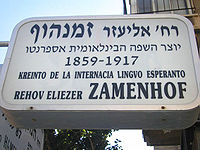 Eliezer Zamenhof street in Tel Aviv: the street sign in Hebrew and Esperanto states he is the creator of the international language Esperanto.
Eliezer Zamenhof street in Tel Aviv: the street sign in Hebrew and Esperanto states he is the creator of the international language Esperanto.
In some Israeli cities, street signs identify Esperanto's creator and give his birth and death dates, but refer to him solely by his Jewish name Eliezer (a variant of which, El'azar, is the origin of Lazarus). Zamenhof is honored as a deity by the Japanese religion Oomoto, which encourages the use of Esperanto among its followers. Also, a genus of lichen has been named Zamenhofia rosei in his honour.[15]
His birthday, December 15, is celebrated annually as Zamenhof Day by users of Esperanto. On December 15, 2009, Esperanto's green-starred flag flew on the Google search web page, in a commemorative Google Doodle to mark Zamenhof's 150th birthday.[16]
The house of the Zamenhof family, dedicated to Ludwik Zamenhof and the Białystok Esperanto Centre, are sites of the Jewish Heritage Trail in Białystok, which was opened in June 2008 by volunteers at The University of Białystok Foundation.[17]
See also
- The Life of Zamenhof
- The Ludwik Zamenhof Centre in Białystok
- 1462 Zamenhof, a minor planet named in Zamenhof's honour
- 1421 Esperanto, another minor planet, similarly named
Notes
- ^ Birth Certificate N 47: "Leyzer Zamengov, son of Mordkha Fayvelovich Zamengov and Liba Sholemovna Sofer"
- ^ In a letter to a Th. Thorsteinsson dated 1901 March 08 he wrote, Mia gepatra lingvo estas la rusa; sed nun mi parolas pli pole... "My mother tongue is Russian, but now I speak more Polish..." See also his biographers A. Zakrzewski and E. Wiesenfeld.
- ^ Claude Piron, "Kontribuaĵo al la studo pri la influoj de la jida sur Esperanton", Jewish Language Review, 4, 1984 [1]
- ^ Holzhaus, Adolf: Doktoro kaj lingvo Esperanto. Helsinki : Fondumo Esperanto. 1969
- ^ Keith Brown and Sarah Ogilvie, Concise Encyclopedia of Languages of the World (Elsevier, 2009: ISBN 0080877745), p. 375.
- ^ Vilnius, 1909; see Esperanto translation as Pri jida gramatiko kaj reformo en la jida in Hebreo el la geto: De cionismo al hilelismo, Eldonejo Ludovikito, vol. 5, 1976
- ^ a b c N. Z. Maimon (May–June 1958). "La cionista periodo en la vivo de Zamenhof". Nica Literatura Revuo (3/5): 165–177. http://donh.best.vwh.net/Esperanto/Literaturo/Revuoj/nlr/nlr35/cionistau.html.
- ^ Hoffmann, Frank W.; William G. Bailey (1992). Mind & Society Fads. Haworth Press. ISBN 1560241780., p. 116: "Between world wars, Esperanto fared worse and, sadly, became embroiled in political power moves. Adolf Hitler wrote in Mein Kampf that the spread of Esperanto throughout Europe was a Jewish plot to break down national differences so that Jews could assume positions of authority.... After the Nazis' successful Blitzkrieg of Poland, the Warsaw Gestapo received orders to 'take care' of the Zamenhof family.... Zamenhof's son was shot... his two daughters were put in Treblinka death camp."
- ^ Wincewicz, Andrzej; Sulkowska Mariola, Musiatowicz Marcin, Sulkowski Stanislaw (Jun. 2009). "Laryngologist Leon Zamenhof--brother of Dr. Esperanto". American journal of audiology (United States) 18 (1): 3–6. doi:10.1044/1059-0889(2008/08-0002). ISSN 1059-0889. PMID 18978199.
- ^ Umberto Eco & James Fentress (September 9, 1995). The Search for the Perfect Language. Blackwell Publishing. p. 324. ISBN 0-631-17465-6.
- ^ Nobel Prize nomnination database
- ^ Olaizola, Borja. "Chatear en Esperanto, vigésimo idioma del mundo más usado en la red." El Correo. 30/03/2011.
- ^ See the list of Zamenhof/Esperanto Objects on the Wikipedia in Esperanto
- ^ Hommages au Dr Zamenhof, à l’espéranto et à ses pionniers.
- ^ Zamenhofia rosei: Francis' lichen. Range, habitat, biology.
- ^ Google logos 4thQ'09 archive page. Retrieved 2010-04-01.
- ^ Jewish Heritage Trail in Białystok accessed July 25, 2009.
References
- Elwood, Ann (1975). "Toward a Universal Language". The Peoples Almanac. Garden City NY: Doubleday and Company. ISBN 0-385-04060-1.
- Le Petit Robert: 'Zamenhof'. Paris; Montréal: Dictionnaires Le Robert, 1990. ISBN 2-85036-074-0.
- Schmadel, Lutz D (1993). Dictionary of Minor Planet Names (2 ed.). Berlin; New York: Springer-Verlag. ISBN 3-540-66292-8.
- Wincewicz, A; M. Sulkowska; S. Sulkowski (2007). "To heal the mind's eye of hate--Dr. Ludwik Zamenhof" (PDF). Isr Med Assoc J 9 (5): 352–4. PMID 17591370. http://www.ima.org.il/imaj/ar07may-2.pdf.
- Korĵenkov, Aleksander (2009). Homarano : La vivo, verkoj kaj ideoj de d-ro L.L.Zamenhof (1 ed.). Kaliningrad; Kaunas: Sezonoj; Litova Esperanto-Asocio. pp. 320. ISBN 9786099508702.
External links
- Zamenhof, Esperanto's founder (in English) on lernu!, an Esperanto study portal
- Zamenhof: The Life, Works, and Ideas of the Author of Esperanto by Aleksandr Korzhenkov – a 53 pages scholarly text abridged from a 2009 book (in English)
- Works by L. L. Zamenhof at Project Gutenberg (in Esperanto)
- ZAMENHOF, LAZARUS LUDWIG by Joseph Jacobs, Isidore Harris. Jewish Encyclopedia, 1906 ed.
- L.L. Zamenhof and the Shadow People by Esther Schor, The New Republic, December 30, 2009
Categories:- 1859 births
- 1917 deaths
- People from Białystok
- Russian inventors
- Polish inventors
- Translators of the Bible into Esperanto
- Polish Esperantists
- Esperanto history
- Esperanto literature
- Language creators
- Polish ophthalmologists
- Polish linguists
- Polish Jews
- Ashkenazi Jews
- Deified people
- Jewish inventors
Wikimedia Foundation. 2010.


